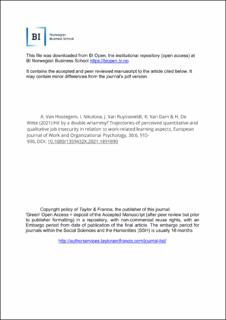| dc.contributor.author | Van Hootegem, Anahi | |
| dc.contributor.author | Nikolova, Irina | |
| dc.contributor.author | Van Ruysseveldt, Joris | |
| dc.contributor.author | Van Dam, Karen | |
| dc.contributor.author | De Witte, Hans | |
| dc.date.accessioned | 2022-05-31T14:03:45Z | |
| dc.date.available | 2022-05-31T14:03:45Z | |
| dc.date.created | 2021-02-16T09:35:17Z | |
| dc.date.issued | 2021 | |
| dc.identifier.citation | European Journal of Work and Organizational Psychology. 2021, Volume 30 issue 6. | en_US |
| dc.identifier.issn | 1359-432X | |
| dc.identifier.uri | https://hdl.handle.net/11250/2997087 | |
| dc.description.abstract | The aim of this study was to identify developmental patterns of job insecurity, taking into account quantitative as well as qualitative job insecurity, and to examine if these groups vary with regard to different work-related learning aspects, that is, occupational self-efficacy, learning from supervisor and colleagues, and acquired knowledge and skills (KSAOs). We conducted latent class growth analysis using three-wave data of 1366 Dutch employees. Five job insecurity patterns were identified: (1) high stable (n = 132), (2) moderate-low stable (n = 555), (3) low stable (n = 217), (4) decreasing (n = 357) and (5) increasing (n = 105). In every class, the change pattern was similar for quantitative and qualitative job insecurity. Those in trajectories with high initial levels of job insecurity had lower initial levels of occupational self-efficacy, learning from others, and KSAOs than those with low initial levels of job insecurity. Additionally, job insecurity trajectories differed in the development of occupational self-efficacy over time. The findings indicate that there are distinct trajectories of the combination of quantitative and qualitative job insecurity, and that these demonstrate a substantial amount of heterogeneity concerning work-related learning. | en_US |
| dc.language.iso | eng | en_US |
| dc.publisher | Taylor & Francis | en_US |
| dc.rights | Navngivelse-Ikkekommersiell 4.0 Internasjonal | * |
| dc.rights.uri | http://creativecommons.org/licenses/by-nc/4.0/deed.no | * |
| dc.subject | job insecurity | en_US |
| dc.subject | self-efficacy | en_US |
| dc.subject | workplace learning | en_US |
| dc.subject | conservation of resources theory | en_US |
| dc.subject | latent class growth analysis | en_US |
| dc.subject | person-centred approach | en_US |
| dc.title | Hit by a double whammy? Trajectories of perceived quantitative and qualitative job insecurity in relation to work-related learning aspects. | en_US |
| dc.title.alternative | Hit by a double whammy? Trajectories of perceived quantitative and qualitative job insecurity in relation to work-related learning aspects. | en_US |
| dc.type | Peer reviewed | en_US |
| dc.type | Journal article | en_US |
| dc.description.version | acceptedVersion | en_US |
| dc.rights.holder | Taylor & Francis | en_US |
| dc.source.pagenumber | 16 | en_US |
| dc.source.volume | 30 | en_US |
| dc.source.journal | European Journal of Work and Organizational Psychology | en_US |
| dc.source.issue | 6 | en_US |
| dc.identifier.doi | 10.1080/1359432X.2021.1891890 | |
| dc.identifier.cristin | 1890208 | |
| cristin.ispublished | true | |
| cristin.fulltext | postprint | |
| cristin.qualitycode | 1 | |

